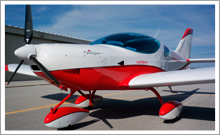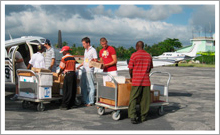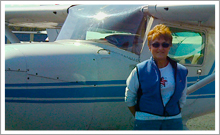| ||||
| | GA News | Safety & Proficiency | member benefits | Quiz Me | |||
Click here to view this week's custom content online today’s top storiesPiper jumps into LSA market Flying the PiperSportAOPA Pilot Senior Editor Dave Hirschman had the chance to fly the new PiperSport at the U.S. Sport Aviation Expo and filed this report: “Acceleration seems unusually brisk for such a diminutive airframe and powerplant, and the PiperSport reached its 45-knot rotation speed in about 300 feet. The rudder has plenty of authority, and tracking the centerline is a simple matter. Even though I’d been warned that the PiperSport is light in pitch, I still managed to over-rotate on takeoff. Yeah, it’s light in pitch, and the elevator works really well, too—even at just 45 knots. Best rate of climb is 65 knots, and the rate is impressive: about 1,000 feet per minute and a 12-degree deck angle with two FAA-standard-size adults aboard (and almost full tanks on an 80-degree F day).” Read more >> GA NEWSHaiti relief: Pilots step up to help Haiti relief: Dominican Republic private pilots provide aidThe Dominican Republic’s private pilot community has set up a command center at Santo Domingo’s main airport to aid Haiti rescue flights. The airport has served as an aerial support bridge to Haiti since the first day of the earthquake. Read more >> Haiti relief: NASCAR aircraft help ferry relief suppliesHendrick Motorsports has loaned two 45-passenger team airplanes and 10 volunteer staff members, including pilots, to Missionary Flights International for Haiti relief efforts. The team also provided a special exemption from the FAA to allow the twin-engine turboprop Saab 2000 aircraft to operate into Port-au-Prince. Read more >> TSA nominee withdrawsThe Obama administration’s nominee for the top spot at the Transportation Security Administration, Erroll G. Southers, withdrew his name from consideration Jan. 20 after his nomination stalled in the Senate. “AOPA continues to support commonsense enhancements to general aviation security that have real and positive effects on national security while imposing the least possible burden on general aviation pilots,” said AOPA President Craig Fuller. “The association has a strong working relationship with the Transportation Security Administration at the operational level, and looks forward to developing a similar relationship with the new administrator once that person is nominated by the president and confirmed by the Senate.” Read more >> Politicians & Planes: A passion emerges from grief AOPA at AERO Friedrichshafen D.C. SFRA off limits during State of the Union addressThe Washington, D.C., Special Flight Rules Area (SFRA) will essentially become a no-fly zone for general aviation pilots on Jan. 27 for President Barack Obama’s State of the Union address. While the FAA has not released the specific time period the airspace will be off limits, the agency has issued a flight advisory detailing the restrictions that will be in place. “Pilots flying in the Washington, D.C., area that day should exercise extreme caution and ensure that they do not stray close to the SFRA,” said Brittney Miculka, AOPA manager of security. For details of the flight restrictions, see the FAA’s flight advisory. China a major growth area for helicopter industryIn 2008 an earthquake in the Sichuan region of China resulted in many casualties, and Chinese officials cite the failure of emergency teams to reach inaccessible areas as the reason. A few months later a major earthquake hit Japan, but much fewer casualties were reported. The reason turned out to be the availability of helicopters to quickly reach the wounded. This has convinced China’s leaders that they must dramatically increase their helicopter fleet. Read more >>
For daily news updates, see AOPA Online. ga serves americaAerial animal tracking Safety & Proficiency10 things ‘other’ pilots do wrongWhat can bring weekend recreational pilots and corporate turbine pilots into one room, get them laughing while they share safety tips, and leave them debating some techniques for up to an hour and a half? The AOPA Air Safety Foundation’s latest Safety Seminar, “10 Things Other Pilots Do Wrong,” which recently started its national run in Northern California. “While we cannot usually get everyone to agree about the specific technique or operation, everyone does seem to agree that safety is the bottom line,” wrote seminar presenter Andy Miller. “Almost every pilot I talked with after the seminars mentioned that he or she was surprised to learn that something they were routinely doing was something that caused other pilots heartburn!” Find out when this popular seminar will be in your area to share your pet peeves and, perhaps, learn a few things that you do to make other pilots shake their heads. See the schedule >> Never too old Flying blind: What not to doYou wouldn’t drive at night without your lights on. You wouldn’t jog blindfolded through a park. And you wouldn’t make it far driving a motorcycle with your eyes covered. The same should be true of VFR pilots continuing flight into instrument meteorological conditions (IMC). Unfortunately, that scenario causes nearly half of all weather-related accidents. To get the message out about the safety hazard of flying VFR into IMC, the AOPA Air Safety Foundation created “Flying Blind,” a tongue-in-cheek Pilot Safety Announcement. Watch the video >> Never Again Online Podcast: New Year's resolutionA Bonanza on a night flight to Atlanta encounters severe turbulence in a fast-moving weather system. Find out how the pilot escaped in the Never Again Online Podcast. Enjoy the lessons you learn from these pilots? Listen to more stories in AOPA's Never Again Podcast directory brought to you by the AOPA Insurance Agency. Webinar to explain Jeppesen VFR+GPS chartsWith a different look and feel from the FAA’s sectional charts, Jeppesen’s VFR+GPS aeronautical charts offer an alternative that is meant to dovetail with the use of GPS for navigation. The charts are designed around common VFR flight plans and local operations, and they include features such as GPS waypoints. Pilots can find out more about the charts and how they differ from FAA sectionals in a Webinar, “Getting to know Jeppesen VFR+GPS charts,” on Friday, Jan. 22, at 4:30 p.m. Dave McLean of Jeppesen will explain the features of and technology behind the charts and answer questions in the 30-minute Webinar. Register to participate on the AOPA Webinar page. blogsAOPA Now: Plane crazy in CaliforniaOn Jan. 16, AOPA President Craig Fuller joined in the festivities of Plane Crazy Saturday in Mojave, Calif. The event takes place every third Saturday of the month to encourage the broader community to come out to the airport, talk to pilots, and enjoy some of the camaraderie and fun that the general aviation community has in such abundance. During his visit, he even got to see some of the innovative aircraft being built at the airport, which is home to the folks who designed, built, and flew SpaceShipOne. Read more >> AOPA Outreach: Celebrating the past, planning for the futureA little less than seven years after the Wright brothers' first flight, 254,000 attendees witnessed amazing feats of flight near Los Angeles at the first Air Meet. AOPA Foundation President Karen Gebhart looked back at the history of aviation and ahead to its future at a celebration of the Air Meet's 100th anniversary last week at California State University, Dominguez Hills. Read more >> Air Safety eJournal: Pattern police?Probably every pilot has been in the pattern at a nontowered airport where there was more traffic than could be comfortably handled. This typically happens on a flying season weekend, between 10 a.m. and 6 p.m. in good VFR weather. That, not coincidentally, describes exactly when and where most midair collisions take place. Prophetically, “final” approach is where most of the final flights take place. What to do—if anything? Read more >> Hover Power: Safer night opsThreats that are clearly visible during the day are masked by darkness at night. In fact, controlled flight into terrain (CFIT) at night is a major problem for rotary-wing operations. CFIT at night during VMC has been especially troublesome for helicopters in the air medical industry. According to the Air Medical Physician Association, half of all EMS accidents happen at night. Read more >> member benefitsMoving up? Be sure insurance is part of your transition planWhen it comes to moving up to a newer, more complex, or faster aircraft, it’s important to have a transition plan. You’ll need to do your homework, get training, and consider your insurance needs. “It’s a good idea to talk to your insurance broker before you start shopping for that new airplane,” said Brenda Jennings, senior vice president of the AOPA Insurance Agency. Read more >> Hire your own legal departmentParticipation in the AOPA Legal Services Plan is a wise and affordable decision. For just $33 a year, you have more than 600 attorneys on call for you. If you get yourself into a jam involving your flying, your business lawyer or tax lawyer, no matter how trusted that person may be, may not be your best choice. Read more >> Quiz MeHere's a question asked by an AOPA member who contacted our aviation services staff through the AOPA Pilot Information Center. Test your knowledge.
Question: I previously asked whether a flight instructor with the following qualifications could give instrument instruction in a multiengine airplane: commercial pilot certificate with airplane single- and multiengine land; instrument airplane and flight instructor with airplane single-engine land; and instrument airplane. In light of the Jan. 4, 2010, FAA letter of interpretation (LOI), can this CFI still give instrument instruction in a multiengine airplane?
Answer: No. The recent LOI from the FAA’s Office of the Chief Counsel clearly states you must hold appropriate category and class of airplane on both your pilot and flight instructor certificate in order to give instrument training in an airplane. So the CFI described above will need to add a multiengine rating to his/her flight instructor certificate in order to be authorized to provide instrument training in a multiengine airplane. (One exception—a CFI training a student pilot may still give “basic instrument maneuver” training under 61.104 and 61.109 without needing an instrument rating on his or her flight instructor certificate.)
Please note that the previous Quiz Me answer from Jan. 1 was correct at the time according to previously issued FAA letters. However, the changes to Part 61 that took place on Oct. 20, 2009, have led to this new legal interpretation from the FAA which was released after the Jan. 1 Quiz Me. We apologize for any confusion.
Got a question for our aviation services staff? The AOPA Pilot Information Center is a service available to all members as part of the annual dues. Call 800/872-2672, or e-mail to [email protected]. Send comments on our Quiz Me! questions to [email protected]. Picture Perfect
Aviation Events & Weather Flight Instructor Refresher ClinicsThe next AOPA Air Safety Foundation Flight Instructor Refresher Clinics are scheduled in Rochester, N.Y., Portland, Ore., and Sevierville, Tenn., Jan. 30 and 31; Las Vegas, Nev., Feb. 13 and 14; Sacramento, Calif., Melbourne, Fla., Louisville, Ky., and Nashua, N.H., Feb. 20 and 21; Baton Rouge, La., Oklahoma City, Okla., Dallas, Texas, and Ashburn, Va., Feb. 27 and 28. For a complete schedule, see AOPA Online.
Can't make it in person? Sign up for the CFI Refresher Online. AOPA Air Safety Foundation Safety SeminarsAOPA Air Safety Foundation Safety Seminars are scheduled in San Diego, Calif., Jan. 25; Costa Mesa, Calif., Jan. 26; Ontario, Calif., Jan. 27; Burbank, Calif., Jan. 28; Little Rock, Ark., Feb. 1; Oklahoma City, Okla., Feb. 2; Wichita, Kan., Feb. 3; Ocala, Fla., Feb. 8; Tampa, Fla., Feb. 9; Melbourne, Fla., Feb 10. Topics vary—for details and a complete schedule, see AOPA Online. | Got news? Contact ePilot. Having difficulty using this service? Visit the ePilot Frequently Asked Questions now at AOPA Online or write to [email protected]. | ||
| Member Tools : Send feedback | Update member profile | Change email address | Unsubscribe | ePilot Archive ePilot Team |

 Piper Aircraft announced Jan. 21 at the U.S. Sport Aviation Expo in Sebring, Fla., that it is entering the light sport aircraft category with the PiperSport, a rebranded aircraft built in the Czech Republic that was formerly known as the Sport Cruiser. “Seventy-five years ago, Piper offered an aircraft that was easy to learn in, fun to fly, and affordable,” said Piper CEO Kevin Gould, hearkening back to the company’s origins and the legendary J-3 Cub. “The PiperSport has the same characteristics, and it will have the same impact on aviation. It’s a blast to fly, and it will lead people to fall in love with our sport and our industry.”
Piper Aircraft announced Jan. 21 at the U.S. Sport Aviation Expo in Sebring, Fla., that it is entering the light sport aircraft category with the PiperSport, a rebranded aircraft built in the Czech Republic that was formerly known as the Sport Cruiser. “Seventy-five years ago, Piper offered an aircraft that was easy to learn in, fun to fly, and affordable,” said Piper CEO Kevin Gould, hearkening back to the company’s origins and the legendary J-3 Cub. “The PiperSport has the same characteristics, and it will have the same impact on aviation. It’s a blast to fly, and it will lead people to fall in love with our sport and our industry.”  While many pilots are helping with the disaster relief efforts in Haiti by donating funds, some have connected with organizations and started using their aircraft to help deliver supplies. General aviation pilots are still asked to not fly into Port-au-Prince to avoid interfering with relief efforts there, but some outlying airports in Haiti are open and pilots are delivering supplies to them from the Bahamas and Dominican Republic.
While many pilots are helping with the disaster relief efforts in Haiti by donating funds, some have connected with organizations and started using their aircraft to help deliver supplies. General aviation pilots are still asked to not fly into Port-au-Prince to avoid interfering with relief efforts there, but some outlying airports in Haiti are open and pilots are delivering supplies to them from the Bahamas and Dominican Republic.  Vermont Rep. Janice Peaslee’s only experience in airplanes before 2000 was taking commercial flights while traveling with her husband, Bert. After his death in 1999, she looked for a way to cope with the grief. She decided to look into learning to fly: It was an undertaking that would honor the flying she had enjoyed with her husband but be different from it. She discovered a passion for aviation, and over the next nine years met the challenges of ground school, endured a 17-month hiatus for an engine overhaul, and practiced until she was sure she would far exceed the practical test standards. Now she pulls her private pilot certificate from her wallet and shows it to her colleagues in the state house, pointing out Wilbur and Orville Wright on the back. “It’s the most gorgeous thing I could ever think of,” she says, beaming.
Vermont Rep. Janice Peaslee’s only experience in airplanes before 2000 was taking commercial flights while traveling with her husband, Bert. After his death in 1999, she looked for a way to cope with the grief. She decided to look into learning to fly: It was an undertaking that would honor the flying she had enjoyed with her husband but be different from it. She discovered a passion for aviation, and over the next nine years met the challenges of ground school, endured a 17-month hiatus for an engine overhaul, and practiced until she was sure she would far exceed the practical test standards. Now she pulls her private pilot certificate from her wallet and shows it to her colleagues in the state house, pointing out Wilbur and Orville Wright on the back. “It’s the most gorgeous thing I could ever think of,” she says, beaming.  This year’s AERO Friedrichshafen trade show and aircraft exhibit will feature a new level of participation by AOPA and its international organization—the International Council of Aircraft Owner and Pilot Associations (IAOPA). Held from April 8 through 11 at Friedrichshafen (in the extreme south of Germany on the shore of Lake Constance), the AERO show continues to grow in popularity as Europe’s largest GA-only event. This year’s AERO will feature an expanded IAOPA presence, to include presentations on current and future European aviation issues.
This year’s AERO Friedrichshafen trade show and aircraft exhibit will feature a new level of participation by AOPA and its international organization—the International Council of Aircraft Owner and Pilot Associations (IAOPA). Held from April 8 through 11 at Friedrichshafen (in the extreme south of Germany on the shore of Lake Constance), the AERO show continues to grow in popularity as Europe’s largest GA-only event. This year’s AERO will feature an expanded IAOPA presence, to include presentations on current and future European aviation issues.  Pilot Roger Stradley likes to take off early during the summer months—usually before 6:30 a.m. The air is smoother then, and he’ll be able to get more accomplished before the inevitable afternoon winds and thunderstorms batter his tiny Piper Super Cub. Flying low over the foothills rising to Swan Lake Flats in Yellowstone National Park, he keeps an eye on the terrain as he scours the ground looking for wildlife. He is about to turn the airplane around when he sees a solitary wolf in the middle of a small clearing looking up at the airplane. Unafraid, the animal gives Stradley an insouciant look before sauntering into the shelter of the trees. Stradley exhales deeply. Even after more than 40 years of spotting wildlife, he never gets blasé about seeing magnificent creatures.
Pilot Roger Stradley likes to take off early during the summer months—usually before 6:30 a.m. The air is smoother then, and he’ll be able to get more accomplished before the inevitable afternoon winds and thunderstorms batter his tiny Piper Super Cub. Flying low over the foothills rising to Swan Lake Flats in Yellowstone National Park, he keeps an eye on the terrain as he scours the ground looking for wildlife. He is about to turn the airplane around when he sees a solitary wolf in the middle of a small clearing looking up at the airplane. Unafraid, the animal gives Stradley an insouciant look before sauntering into the shelter of the trees. Stradley exhales deeply. Even after more than 40 years of spotting wildlife, he never gets blasé about seeing magnificent creatures.  Thinking about adding a new rating or certificate or completing training for your initial pilot certificate but wonder if you are too old? The FAA doesn’t have an upper age limit for obtaining a pilot certificate, so go for it! According to AOPA’s subject report on older student pilots, “doing new things like learning to fly is one of the guaranteed ways to keep the energy levels up regardless of a person's age.”
Thinking about adding a new rating or certificate or completing training for your initial pilot certificate but wonder if you are too old? The FAA doesn’t have an upper age limit for obtaining a pilot certificate, so go for it! According to AOPA’s subject report on older student pilots, “doing new things like learning to fly is one of the guaranteed ways to keep the energy levels up regardless of a person's age.” 
